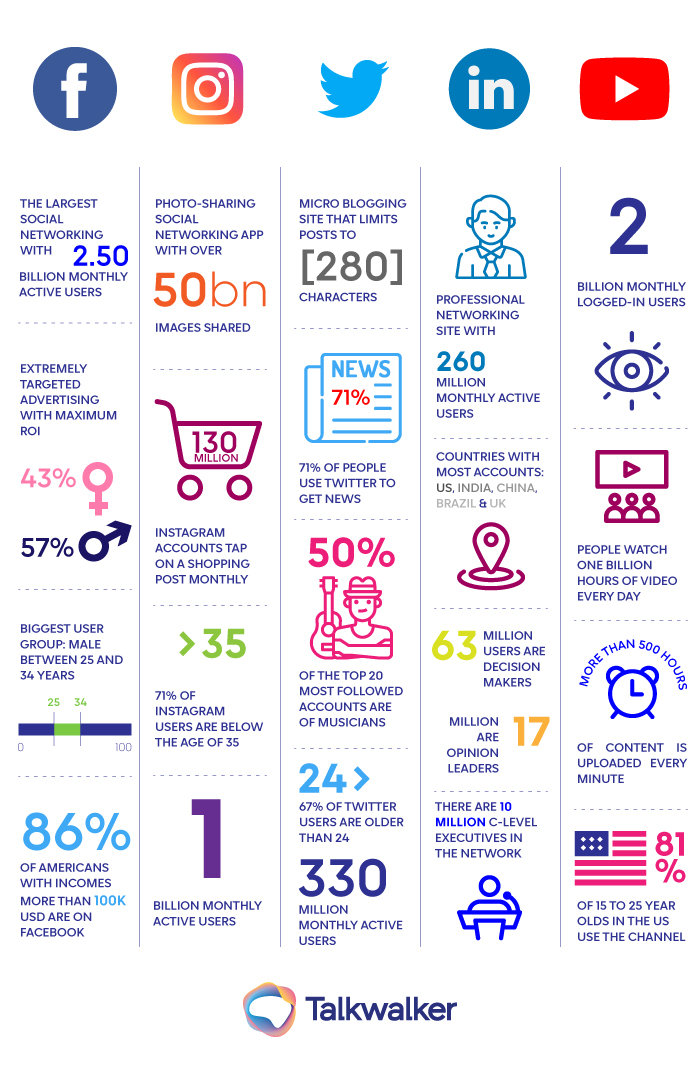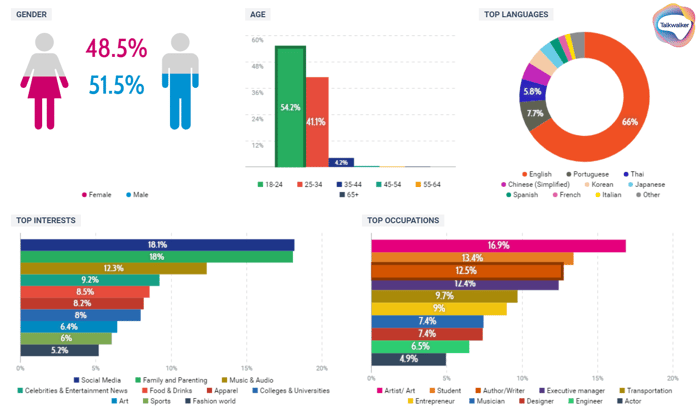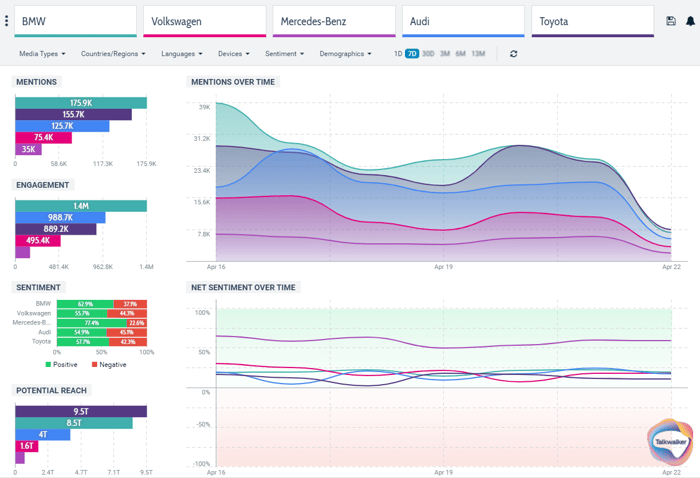Use Talkwalker Free Social Search to gather social insights
In this blog, I will discuss each step for creating a social media marketing strategy that will help you achieve your goals.
#1 Set your marketing goals
Begin with asking yourself a key question: What is my business objective and what do I wish to achieve through social media? Is the objective to increase brand awareness, create more engagement, or drive more revenue? Your marketing goals must be in line with the business objective.
Second, make sure that you define your goals in a SMART format:
- Specific: Your goal should not be ambiguous. You must have a clear target in order to focus your efforts in the right direction.
- Measurable: Determine your target in a numeric form. This will allow you to measure your progress and change your path in case you find yourself too far off the target.
- Attainable: You must be ambitious about your goals. However, set your goals in line with the resources and capabilities at hand.
- Relevant: Your goal should matter to you and the overall business. If the business objective is to grow revenue, your goal could be to increase leads generation by x% via social media.
- Time-bound: Of course, every goal needs to have a start and finish date. Without time constraint, there will be no urgency to meet objectives and achieve the goals. Moreover, a start and finish date will help you measure the success or failure of your campaigns
Here are some examples of common social media marketing goals in a SMART format:
| Business objective | Marketing Goal in SMART Format |
| Increase brand awareness | By using targeted advertising, we will increase the number of Twitter followers by 2X by December 2020. |
| Grow Revenue | Run promotional campaigns on Facebook to increase form submissions and email signups by 50% by August 2020. |
| Improve customer retention | Maintain an average response time of 60 minutes for customer queries on all social media channels to generate 500 positive customer testimonials by the end of 2020. |
..
#2 Define your target audience & create buyer personas
Before you start your social media campaign, you must understand your target audience. For your research, you should use an advanced social media analytics software. I suggest using Talkwalker’s Free Social Search tool. You can search for your brand/hashtag on this tool and understand who is talking about you and what is being said. You can fine-tune your search depending on your geography, language, media type/channels, devices, and more. You can also use Boolean syntax to bring accuracy to your search query and remove unwanted results.
Through the tool you will be able to access a world of data that will help you create your buyer personas. You will be able to see the top themes people are talking about in relation to your brand. You can also filter results by engagement and find the top questions, concerns, positive/negative comments given by your audiences.
Demographic data from Talkwalker Free Social Search.
Use this data to create a detailed buyer persona and target the right audience through your social media marketing campaigns. Download this document for a buyer persona template. Here is what you should include in your buyer personas:
- Personal information: Age, gender, location, interests
- Professional information: Designation/seniority, domain, industry Customer
- Goals: What they want to achieve
- Customer pain points: What issues are you trying to address?/why the customer needs your service
- Customer gains: How will your product/service resolve the issue and ease the life of your customer?
- Online presence: Which platforms do they use?
Once you create a detailed buyer persona, you will be able to design campaigns that will address specific pain points. Better targeted campaigns will mean better quality in terms of results.
#3 Select the right social media channels
Once you have the buyer personas, you will be able to select the channels that you wish to use. Not all social media channels are equally important for all businesses. You need to access where your target audience is most active and how they consume data on each of these platforms.
Here is a short infographic that will give you a perspective on audience demography on the biggest social media platforms and how people are using these channels:

Currently Facebook stands as the largest social networking platform with 2.5 billion monthly active users. Out of these 2.50 billion users, 43% are female and 57% are male. The biggest user group is that of males between the age of 25 to 34 years. 86% of internet users in the United States with household earnings of more than 100K USD are on Facebook.
Facebook offers extremely targeted advertising due to its large user base. For advertisers, this platform drives maximum ROI.
The photo-sharing social networking app owned by Facebook has 1 billion monthly active users. With over 50 billion images shared to date, 71% of Instagram users are below the age of 35. For advertisers, Instagram offers great engagement rates as 130 million accounts click on a shopping post every month.
The micro blogging site that limits posts to 280 characters has over 330 million monthly active users. In terms of age demographics, 67% of Twitter users are 24 and above. According to a survey conducted by Pew Research Center in 2018, 71% of Americans on Twitter use the platform to get news. Interestingly, 50% of the top 20 most followed handles on Twitter are of musicians. This is followed by accounts of politicians and brands that make up 15% each of the top 20 most followed accounts.
The professional networking site has more than 260 million monthly active users. The greatest number of accounts are from the United States, India, China, Brazil & UK. According to LinkedIn, the network consists of 63 million decision-makers, 17 million opinion leaders and 10 million C-Level executives.
YouTube
YouTube is the biggest online video platform worldwide with over 2 billion monthly logged-in users. More than 500 hours of content is uploaded every minute and people watch one billion hours of video everyday on this platform. In the United States, 81% of 15 to 25-year olds watch videos on this channel.
#4 Research your competitors extensively
It is very important to be ahead of the competition if you want to win the social media race. To begin with, list your top competitors and the platforms they are using. As a next step, you need to study how they are using each platform. What are their strengths and weaknesses? How do they compare with your brand? Benchmark your social results against your competition to find gaps in your social media strategy.
To measure your performance against other brands, you can use Talkwalker’s Free Social Search. Free Social Search will allow you to compare your social media performance with 4 other competitors simultaneously. You will be able to see their mentions, engagement rate, sentiment and reach in a single dashboard. It will also enable you to see their top influencers, their most used hashtags, top themes, types of posts and more.
Competitor analysis using Talkwalker Free Social Search
Once you collect all data about your competitors, conduct a SWOT analysis. List out your strengths and weaknesses as opposed to your competitors and identify opportunities to take advantage. Spot external threats to create strategies to counter them.
#5 Plan the type of content you wish to share
Once you identify which channels you wish to be present on, you should also define the types of content that you will be posting on each of those channels. Each social channel is unique, and the same content might not be relevant for all. While YouTube can be a great platform for posting how-to videos, your Twitter audience might engage more with industry news and blog posts.
The type of content that you select for each channel depends largely on audience expectations and how they consume data on each platform. One of the reasons why celebrities and influencers have huge social followings is because they know exactly how to use each channel. To increase engagement rates, brands must also replicate this in their social media marketing strategy. Tips for social media marketing include identifying the content type that works best on each chennel...
- Facebook – Videos, blog posts, curated content
- Twitter – Industry news, blog posts, tweets on general news/trending topics, curated content
- LinkedIn – Job listings, webinars, blog posts, interviews, content about company & work culture
- Instagram – Stories and images of employees, ad campaigns, events, behind the scenes
- YouTube – Interviews, explainer videos, top-shots, informative motion graphics
#6 Optimizing your social media profiles
You might want to evaluate the visual elements and branding on social media before you begin to use your profiles. Maintain consistency in terms of logo, colors and graphical elements. This will make it easy for people to find and recognize your brand.
Ensure that you fill your bio with the right information. Your profile details should be short, catchy and include all key messages. Don’t forget to include links of relevant landing pages to your website.
Each social channel has a different specification for uploading profile and cover images. Adapt your images to these specifications so that they don’t appear stretched.
#7 Identify the best time to post and create a social media calendar
Most social media platforms use complex algorithms to filter results and show the most relevant posts to their audiences. Which makes timing an extremely important aspect while posting on social media. If you post your content at a time when your audience is offline, they might never see your posts. If you want detailed information on the best time to post on your social channel, download this document.
After identifying the best times to post on social media, create a detailed content calendar. This will allow you to plan your social media activities in advance and keep a record of all social media channels in one place. If you are using multiple social channels, I highly recommend using a social media scheduling software. Hootsuite is my personal favorite. It allows users to automatically schedule hundreds of social media posts across all social platforms.
#8 Interact with followers
Successful brands use social media for not just broadcasting information but also engaging with their followers. Interacting with followers will help in increasing trust and building a community of brand advocates. Here are some ways in which you can increase engagement on your social media posts:
- Reply to posts that tag you or use your hashtag
- Tag guest bloggers/authors
- Ask questions and encourage people to respond
- Conduct surveys and polls
- Use emoji and GIFs in posts and responses
#9 Use paid promotions to increase your reach
Paid promotions are the best way to reach those audiences that do not follow you currently. With the vast amount of data, social networking sites can help you reach your target demography like no other platform.
The best way to make the most of your advertising budgets is by identifying the most engaging posts/videos and promoting them.
#10 Use influencers to make inroads into forums and groups
You might already have plans to engage with influencers directly on their social media handles. Consider taking this a step further. Most micro influencers are extremely active on forums and groups. These are closed communities that do not allow any form of brand advertising. However, individuals and influencers can become advocates of your brand and speak on your behalf. Incentivise influencers to mention your brand/product on forums as a part of your social outreach strategy.
#11 Monitor your results and adapt your campaign
Despite all the planning, things might not work as expected. Certain campaigns might perform extremely well, while others fall flat. As a social media manager, you might want to review the performance of your campaigns on a daily/weekly basis. Since you have already defined your goals, tracking your progress will not be complicated. Consider using Talkwalker’s Free Social Search for monitoring your campaigns. This tool will enable you to track your campaigns and hashtags for the last 7 days. Moreover, you will be able to capture both tagged and untagged mentions of your brand.







